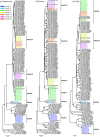Etiological Study of Acute Conjunctivitis Caused by Human Adenovirus in Shanxi Province, China, between 2016 and 2019
- PMID: 37486235
- PMCID: PMC10434163
- DOI: 10.1128/spectrum.00159-23
Etiological Study of Acute Conjunctivitis Caused by Human Adenovirus in Shanxi Province, China, between 2016 and 2019
Abstract
Human adenovirus (HAdV) is the primary cause of acute conjunctivitis. To improve our understanding of the etiology of adenoviral conjunctivitis, ocular samples were collected from 160 conjunctivitis cases in the Shanxi province of northern China between 2016 and 2019. Through preliminary identification, virus isolation, and type identification, a total of 63 HAdV isolates were obtained from the samples. Three species and seven types (HAdV-3, HAdV-4, HAdV-8, HAdV-37, HAdV-53, HAdV-64, and HAdV-85) were detected, with HAdV-64, HAdV-3, and HAdV-8 being the predominant types in 2016, 2018, and 2019, respectively. Further phylogenetic analysis indicated the relative genomic stability of seven HAdV-type strains, except for 4 HAdV-3 strains in 2018 with a novel amino acid insertion site (Pro) between P19 and S20 in the penton base gene. It is worth noting that the genomes of two Shanxi HAdV-85 strains from 2016 were almost identical to those of previously reported HAdV-85 strains that circulated in Japan in 2014 to 2018. China was the second country to sample and isolate HAdV-85, suggesting that HAdV-85 might be underreported as an ocular pathogen. Data obtained in this study provide valuable information on the prevalence of acute conjunctivitis caused by HAdV. IMPORTANCE HAdV types in cases of conjunctivitis in Shanxi province, China, in 2016 to 2019 showed evident diversity, with seven types (HAdV-3, HAdV-4, HAdV-8, HAdV-37, HAdV-53, HAdV-64, and HAdV-85) being identified, and relative genome stability of these viruses was observed. In addition, China was the second country to sample and isolate HAdV-85, which suggests that HAdV-85 might be underreported as an important pathogen associated with ocular infections. These results enhance the understanding of the etiology of adenoviral conjunctivitis and may aid in the development of prevention and control strategies for HAdV-related ocular infections in China.
Keywords: acute conjunctivitis; etiological study; human adenovirus; human adenovirus type 85.
Conflict of interest statement
The authors declare no conflict of interest.
Figures





Similar articles
-
The Epidemic Genotypes of Human Adenovirus in Outpatient Children with Adenoviral Conjunctivitis from 2011 to 2012 in Jiangxi, China.Intervirology. 2019;62(1):30-36. doi: 10.1159/000499963. Epub 2019 May 22. Intervirology. 2019. PMID: 31117098
-
[Genetic characteristics of five human adenovirus type 53 strains isolated from Taiyuan city in 2016, China].Zhonghua Yu Fang Yi Xue Za Zhi. 2019 Dec 6;53(12):1271-1277. doi: 10.3760/cma.j.issn.0253-9624.2019.12.013. Zhonghua Yu Fang Yi Xue Za Zhi. 2019. PMID: 31795585 Chinese.
-
An outbreak of acute respiratory infection at a training base in Beijing, China due to human adenovirus type B55.BMC Infect Dis. 2020 Jul 23;20(1):537. doi: 10.1186/s12879-020-05258-2. BMC Infect Dis. 2020. PMID: 32703176 Free PMC article.
-
Current status of human adenovirus infection in China.World J Pediatr. 2022 Aug;18(8):533-537. doi: 10.1007/s12519-022-00568-8. Epub 2022 Jun 18. World J Pediatr. 2022. PMID: 35716276 Free PMC article. Review.
-
Prevalence of human infection with respiratory adenovirus in China: A systematic review and meta-analysis.PLoS Negl Trop Dis. 2023 Feb 22;17(2):e0011151. doi: 10.1371/journal.pntd.0011151. eCollection 2023 Feb. PLoS Negl Trop Dis. 2023. PMID: 36812245 Free PMC article.
Cited by
-
Human adenovirus type 4 (HAdV-4) associated acute respiratory tract infection in children & genetic characteristics of HAdV-4 in China: a prospective multicenter study.BMC Infect Dis. 2024 Sep 9;24(1):936. doi: 10.1186/s12879-024-09835-7. BMC Infect Dis. 2024. PMID: 39251906 Free PMC article.
-
Whole genome-based surveillance for human adenovirus-related diseases in Kobe City, Japan, 2018-2022.BMC Res Notes. 2025 Apr 15;18(1):170. doi: 10.1186/s13104-025-07225-z. BMC Res Notes. 2025. PMID: 40234980 Free PMC article.
References
-
- Madisch I, Harste G, Pommer H, Heim A. 2005. Phylogenetic analysis of the main neutralization and hemagglutination determinants of all human adenovirus prototypes as a basis for molecular classification and taxonomy. J Virol 79:15265–15276. doi:10.1128/JVI.79.24.15265-15276.2005. - DOI - PMC - PubMed
-
- Ismail AM, Cui T, Dommaraju K, Singh G, Dehghan S, Seto J, Shrivastava S, Fedorova NB, Gupta N, Stockwell TB, Halpin R, Madupu R, Heim A, Kajon AE, Romanowski EG, Kowalski RP, Malathi J, Therese KL, Madhavan HN, Zhang Q, Ferreyra LJ, Jones MS, Rajaiya J, Dyer DW, Chodosh J, Seto D. 2018. Genomic analysis of a large set of currently-and historically-important human adenovirus pathogens. Emerg Microbes Infect 7:10. doi:10.1038/s41426-017-0004-y. - DOI - PMC - PubMed
-
- Li ZJ, Zhang HY, Ren LL, Lu QB, Ren X, Zhang CH, Wang YF, Lin SH, Zhang XA, Li J, Zhao SW, Yi ZG, Chen X, Yang ZS, Meng L, Wang XH, Liu YL, Wang X, Cui AL, Lai SJ, Jiang T, Yuan Y, Shi LS, Liu MY, Zhu YL, Zhang AR, Zhang ZJ, Yang Y, Ward MP, Feng LZ, Jing HQ, Huang LY, Xu WB, Chen Y, Wu JG, Yuan ZH, Li MF, Wang Y, Wang LP, Fang LQ, Liu W, Hay SI, Gao GF, Yang WZ, Chinese Centers for Disease Control and Prevention (CDC) Etiology of Respiratory Infection Surveillance Study Team . 2021. Etiological and epidemiological features of acute respiratory infections in China. Nat Commun 12:5026. doi:10.1038/s41467-021-25120-6. - DOI - PMC - PubMed
Publication types
MeSH terms
LinkOut - more resources
Full Text Sources
Medical

